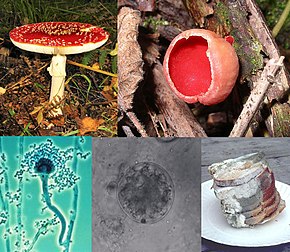Fungus
| Fungi | |
|---|---|

| |
Clockwise frae tap left:
| |
| Scientific classification | |
| (unranked): | Opisthokonta |
| (unranked): | Holomycota |
| (unranked): | Zoosporia |
| Kinrick: | Fungi (L.) R.T.Moore[1] |
| Subkingdoms/Phyla/Subphyla[2] | |
|
Dikarya (inc. Deuteromycota) Subphyla incertae sedis | |
A fungus (/'fʌŋɡəs/; plural: fungi[3] or funguses; aften cried puddockstuil, inspeciallie whan thare is a shank) is a memmer o a muckle group o eukaryotic organisms thit is incluidin o microorganisms sic as baurms an moulds, as weel as the mair familiar mushruims. Thir organisms is clessifee'd as a kinrick, Fungi, whilk is apairt frae plants, animals, protists an bacteria. A muckle differ is thit fungal cells haes cell waas thit hauds chitin, wanalike the cell waas o plants an some protists, whilk hauds cellulose, an unalike bacteriae cell waas. Thir differs, an ithers, shaws thit the fungi furms a unifee'd group o sib organisms, cried the Eumycota (true fungi or Eumycetes), thit skare a common auncestor (is a monophyletic group). This fungal group is distinct frae the structurally seemilar myxomycetes (slime moulds) an oomycetes (watter moulds). The discipline o biology devotit tae the studie o fungi is kent as mycology (frae the Greek μύκης, mukēs, meanin "fungus"). Mycology haes aften been regairdit as a brainch o botany, even tho it is its ain kinrick in biological taxonomy. Genetic studies haes shawn thit fungi is sibber tae ainimals nor tae plants.
